The Club Company carries out renovations with John Greasley
Related Articles
The Club Company, which owns 15 country clubs in the UK, has carried out major renovation works at nine of them recently, with contractor John Greasley Limited playing a major role in each one. Here, the company’s managing director, Charlie Greasley, outlines the work that’s been taking place.
Over the last two years The Club Company has committed to some major course improvement works and specialist golf course contractor John Greasley Ltd has been lucky enough to have played a major part. After working for the company initially in 2016, we have developed a close relationship and been trusted to carry out multiple course improvement schemes across nine of its 15 country clubs. The Club Company owns and operates these clubs throughout the UK, combining a traditional golf environment with state-of-the-art health and fitness facilities.
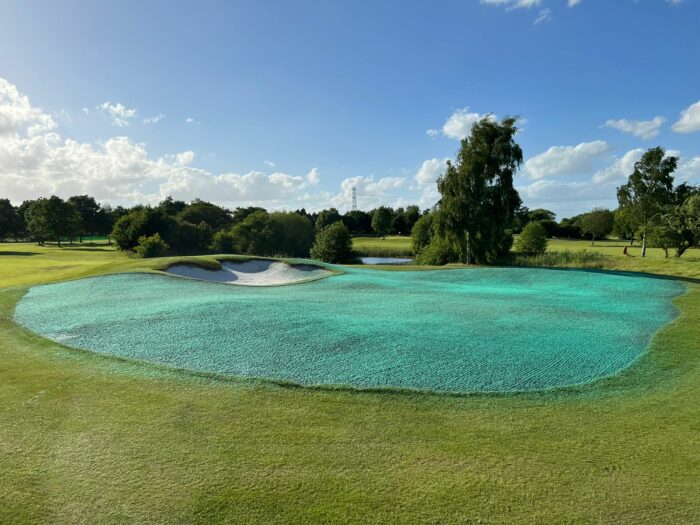
Hydroseeding at Lichfield Golf & Country Club in Staffordshire
A bold strategy has been implemented to renovate and improve a number of courses on either drainage, practice facilities / driving range improvements or complete bunker reconstruction schemes. In order to minimise the disruption to members, a two-phase approach has been adopted for the larger projects. Each phase is separated by either one or two years.
Golf course architect Jonathan Gaunt (director of Gaunt Golf Design) is responsible for the design, masterplanning and overseeing works on site. Jonathan operates a ‘hands-on’ approach on site, from marking our bunkers / features on the ground, spraying sand lines / overseeing alterations on site, through to the final signing off of the finished works. A great system of communication, knowledge and expertise is in place between Jonathan and all our teams at Greasley’s.
Pivotal to implementation of the works from the club’s side has been longstanding group course manager, Chris Brook. ‘Brookie’ has worked for the Club Company since its inception and his wealth of knowledge specific to each course is unprecedented. He is closely involved in each project, operating an on-the-ground approach to supervising the works and growing in. To develop, a good relationship between the club’s key staff, architect and contractor is essential. I can honestly say that the journey so far has been an enjoyable one!
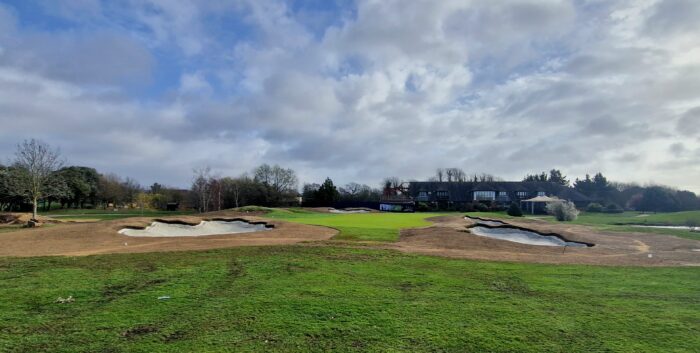
Cams Hall Estate Golf Club, Hampshire
One of the largest is at Nizels GC in Kent where we are currently undertaking the second phase of both bunker reconstruction and fairway drainage. Phase one was completed during the summer of 2021 whereby both drainage and bunker reconstruction went in tandem, the advantage of this was to reduce the number of hole closures and minimise the use of temporary greens and tees. Another advantage of such a method is being able to use the excavated material from the drainage works as fill material for the bunkering. All bunkers on 18 holes and the extensive primary and secondary gravel banding drainage works will be completed by mid-September this year.
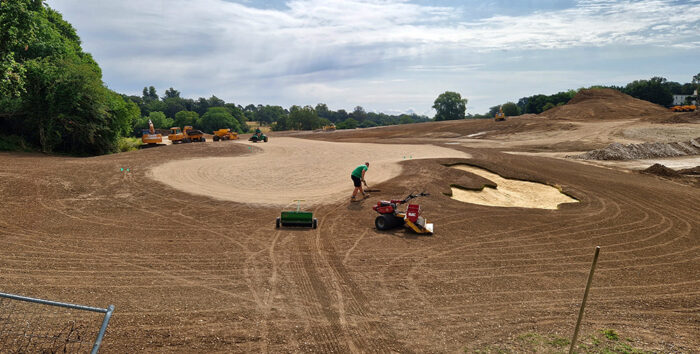
The short game area being prepared at Burnham Beeches
A similar approach has been rolled out at the Lichfield and Cams Hall golf clubs. The ‘two nines’ approach for the major reconstruction of bunkering, in line with Jonathan’s masterplanning, commenced at Lichfield last summer and Cams Hall this winter, between January and April. Both second phases are pressing on this autumn and winter, meaning that all 18 holes on each course will be completed within 12 to 16 months from the projects commencing. The grow-in period for the bunkers is typically three months, depending on the time of year, however one major benefit of the summer / early autumn works is the ability to hydroseed areas. Many of the working areas created are substantial, particularly when bunkers are being re-positioned for the modern game, and at Cams Hall, some bunkers were enormous, in excess of 300 sq.m. each. It would not be cost effective to turf thousands of sq.m. of ‘filled in’ areas due to repositioning and the results from hydroseeding are good, although the areas do require frequent watering to ensure establishment … not always an easy task for the greenkeepers, but a necessary one.
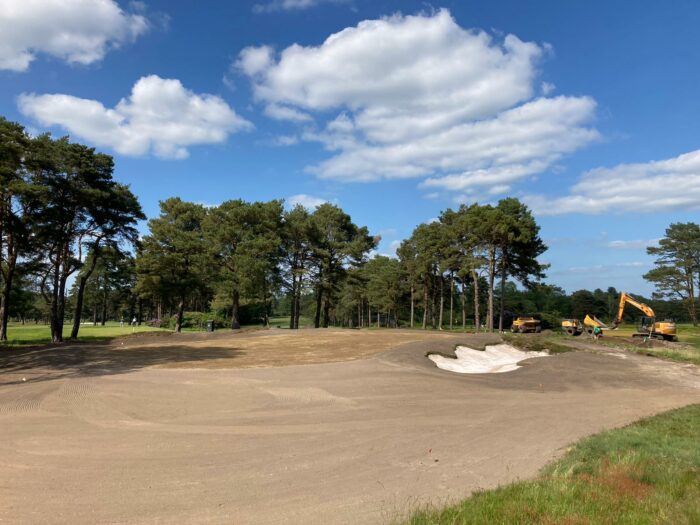
Ferndown’s 9th green, prepared for seeding
During 2022 we installed a series of raised, ‘colour coded’ artificial greens across three of The Club Company’s driving ranges in a back to back sequence, moving from club to club. Part of their investment in Toptracer, the new greens are integrated within the software to create a realistic practice experience. The level of information and feedback that can be gleaned is mind boggling! The success of revamped ranges at Lichfield, The Essex and Wharton Park will lead to further improvements across other courses.
Greasley on the greens
This year has seen continued investment from other golf clubs around the UK, particularly for short game facilities and green construction.
At Ferndown GC we constructed a new 9th green on the Allis, alongside a new putting green. The green surface was ‘cored’ using hollow cores harvested from the existing greens. Heather translocation ‘slabbing’ was also a great feature of the works, providing an instant finish and texture to the outer green and bunker surrounds. Designed by Ken Moody, Creative Golf Design, the new hole is a tremendous improvement and part of the future development of practice facilities.
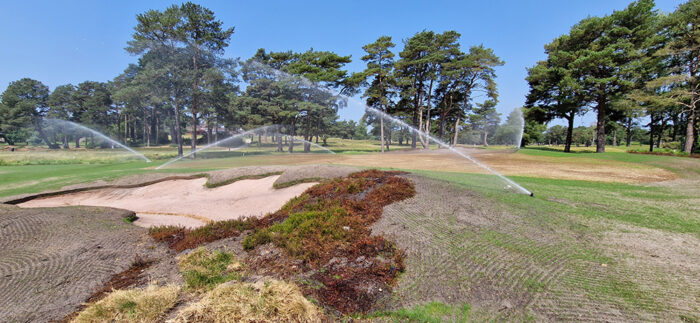
Heather translocation and coring at Ferndown
We have just completed a new chipping and bunker practice green at Burnham Beeches Golf Club designed as part of a larger driving range importation scheme by Bruce Weller, Weller Golf Designs. This substantial green and surrounds is going to provide such an added benefit for the members. We are shortly moving onto the driving range outfield, tee complex with artificial and natural turf surfaces and will be constructing a series of artificial target greens.
Architect’s comments
The course remodelling work we’re currently undertaking for The Club Company at three courses is both bold and forward-thinking, bringing their facilities up to date and offering members and visitors a much-improved playing experience.
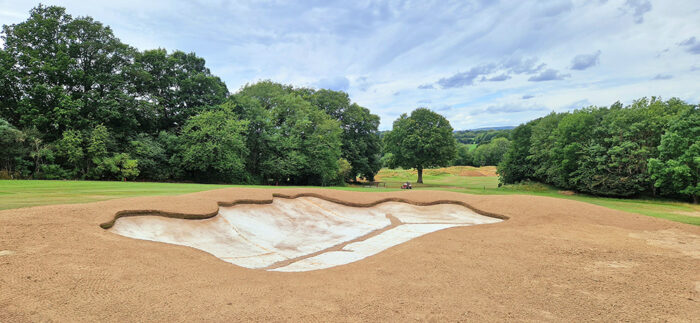
Nizels Golf & Country Club in Kent’s 10th fairway
The work at Cams Hall is on a course originally designed by Clive Clark and Peter Alliss, so it possesses their distinctive design features, notably large, sprawling bunkers which, in the 1990s, was very fashionable, but in 2023 are now inappropriate and expensive to maintain. The course at Cams Hall is located on the banks of the River Wallington, as it flows out to Portsmouth Harbour and it has a definite ‘links’ feel, with an open and exposed aspect with attractive fragmented views of the water. The new well-positioned bunkers will help to transform the playing strategy, making it necessary to think your way around the course to score well, rather than automatically thrashing a driver. In particular, the par threes have been improved with a refinement of the bunker positions to make them more aesthetically appealing and more memorable to play.
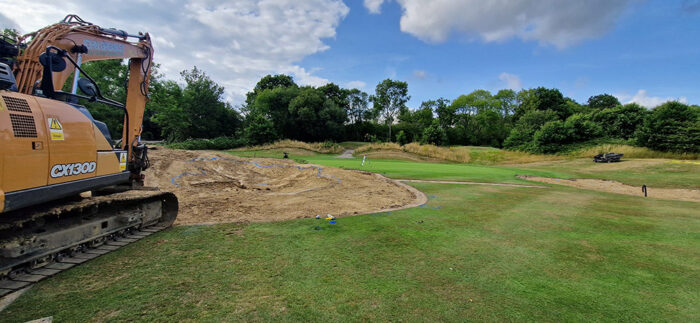
Nizels Golf & Country Club
At Lichfield we have applied similar principles, but, thankfully, the original design, by Simon Gidman, was much more refined. In general, the bunker positions were good, if a bit outdated, but there were just too many of them. So, we have focussed on the rationalisation of bunker numbers and reducing sand areas down in the bunkers we have retained. The new bunkers are raised and designed to be significantly more visible / viewable from the tees and also from landing areas to greens – this strategy pays homage to the work of MacKenzie and Colt and their design principles, which are still as valid and relevant today as they were when they were in their prime in the 1920s and 1930s. The visibility of the sand in bunkers is a really important aspect of any bunker remodelling project and it can transform the ‘look’ of every hole. The advantage of creating greater visibility of the bunkers at Lichfield is that they will have more of a psychological impact upon the golfer playing the course. And, one well-placed bunker can do the job of three badly-positioned bunkers.
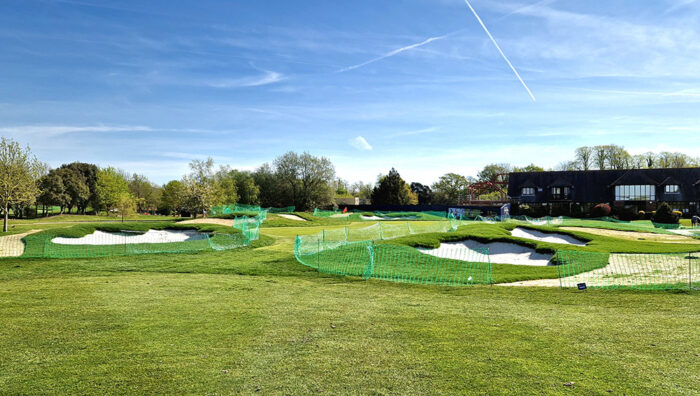
The 9th green at Cams Hall Estate Golf Club, Hampshire
At Nizels in Kent, we have now embarked on phase two of the bunker remodelling programme and the work done so far by Charlie and his team has been extremely well received by members and visitors alike. The course was originally designed by the landowner, not a trained golf course architect. So, our masterplan has focussed on creating a new strategy for play, together with the removal of numerous randomly positioned bunkers and replacement of many of them with grassy hollows, run-offs and swales. The setting of the course is impressive with some extreme changes in elevation and challenging terrain – making for some really impressive views from tee to green. We look forward to completing work by autumn 2023.

























